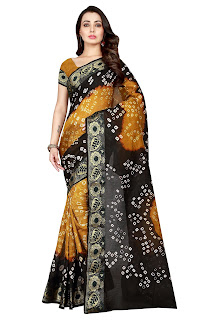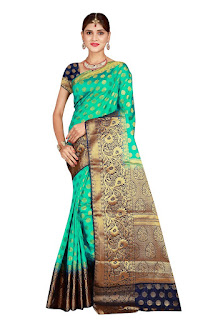Buy Laxmi Bandhani Saree Online
Origin and history
Historians have been able to trace silk work to Vedic times.
banarasi saree surat– literally
translated as cloth made from gold – finds mention in the revered Rig Vedas as
the attire of the Gods. And some scholars believe that this description comes
close to the embellished zari work, synonymous with Banarasi silk sarees. The
timeless Jataka Tales and Pali texts support the evidence of a bustling cloth
trade on the banks of theholy Ganga, in Kashi.
There’s no debating the fact that Banaras has been an
important centre for weaving since time immemorial. But it was banarasi saree photo Akbar who gave the weaving industry,
here and across India, a shot in the arm. The emperor who was known for his
love of the finer things in life – Persian wine, his gem-crusted sword with
crusted elephants, his sarpech (turban ornament) which consisted of large
emeralds in elaborate floral motifs, and more – also loved zari work
(embroidery in pure gold). He had many of his wives and those from his harem wrapped
in rich silk sarees with zari work. And this is what we today popularly refer
to as Banarasi silk, while also adding silver threadwork to the mix.
Emperor Akbar so loved the silk work that he didn’t limit
its use to clothing and even had his palace draped in it – carpets and wall
hangings made from banarasi saree with price . Little wonder that centuries later,
the British colonizers too were baffled by this intricate handicraft. But it
was post independence that several small scale industries grew in the region
and Banarasi silk became much sought after.
Weaving process
I visit banarasi saree online in Hukul Gunj, where a loom sits at
the very entrance with resham threads running through the length and breadth of
the machine. Ojha, of Bressler Silk House, explains how zari threads are made:
flattened thin metallic strips are drawn from gold alloys. These delicate
strips are then wound around silk yarns. The threads are then flattened using
machines. Often they are passed through a brightener to increase their sheen.
While motifs are crafted out of zari threads, the rest of
the banarasi saree blouse is usually made of silk that is dyed
in a variety of colours. In recent years, natural dyes are gaining popularity
due to concerns of the sacred Ganga being polluted from chemical dyes, as dye
manufacturing units populate the area.
Special features
The saree designs are first created on paper: the pattern is
literally punched into paper, making it look much like Braille. A separate
pattern guides each row and hundreds of such patterns, (naksha patras), are
created for a single banarasi saree design .
It is essentially these patras that give you everything from
floral motifs to jali work and more. Based on these patras the dyed silk and
zari threads are wound into the handloom, to create the desired patterns. Given
the effort, the banarasi saree at lowest price often come with a hefty price tag. And
sarees produced on handlooms can take anywhere from a 15 days to a month, and
sometimes upto six months.
Today power looms are replacing the hand-loom, and cutting
down on labour and production time. But the final machine-made product is
uniform, and lacks the distinctiveness of the handmade saree.
Colours
Banarasi sarees are available in a host of colours and are
known more for the gold and silver zari work that adorns them.
Motifs
Back in the Mughal era, the designs on Banarasi sarees
largely consisted of Islamic motifs such as floral patterns, stylised leaves,
and the use of jali work (net), all of which can also be found also in their
architecture. The Taj Mahal boasts of similar motifs in intricate inlay work
crafted from and within stone. The effect is simply stunning. The designs were
an attempt to recreate the bounty of jannat (paradise).
During the British era, the Victorians often demanded
geometric patterns. Today, while Islamic motifs remain popular, one can find a
variety of Hindu Gods embossed on to cushion covers, wall-hangings and even
sarees.
Varieties
Banarasi sarees can be categorized into four distinct
varieties, namely pure silk (katan), organza (kora) with zari and silk,
georgette and shattir. Of these, the pure silk variety is the most renown. On
the basis of design, banarasi saree and price are also classified into jangla,
tanchoi, vaskat, cutwork, tissue and butidar.
Shop different varieties of Banaras sarees.
Current state of the art
The trade that has survived centuries is under threat with
inexpensive fakes flooding the markets. Sadly, many craftsmen have been forced
to switch careers. An authentic banarasi saree buy online takes time and effort to create, and
comes with a hefty price tag. Customers are often unwilling to pay the price of
the labour and willingly opt for fakes. But a visit to Bressler Silk House, a
talk with a craftsman, and watching him at work, is all it will take to realise
the intricacy and beauty of this art. By respecting the craftsman and paying a
fair price, we may be able to preserve this chapter of our history.
On the bright side, banarasi saree and blouse now have the GI (Geographical
Indication) certification for Banaras Brocades and Sarees.




Comments
Post a Comment